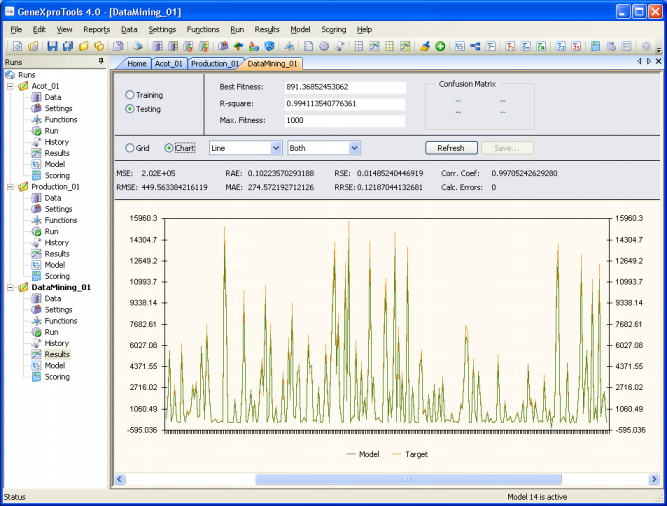In order to test the generalizing capabilities of your model, you must provide an additional set of sample data (testing set) which is only used after the learning process is complete.
To Test the Generalizing Capabilities of a Model with GeneXproTools 4.0
- On the Data Menu, select Add Testing Data.
The Change/Add Testing Data wizard appears. It asks for the type of data source and the path
and format of your testing file. Click on Finish to load the testing set.
- In the Run Panel, after a run, check the best-of-run values of Fitness and R-square/Accuracy obtained for the testing set.
After a run, GeneXproTools evaluates the performance of the evolved model
on the testing set and shows both the fitness and the R-square/Accuracy
obtained on the testing set.
- In the Results Panel, select the Testing option.
Depending on the problem category, you can analyze a varied set of
statistical functions of your model on the testing set. These statistics include: mean squared error, root mean squared error, mean absolute error, relative squared error, root relative squared error, relative absolute error, correlation coefficient,
and R-square for all types of problem category; and the classification error, classification accuracy, confusion matrix (true positives, true negatives, false positives, and false negatives), sensitivity, specificity, positive predictive value, and negative predictive
value for Classification and Logic Synthesis.
- In the Report Panel, check the entry Statistics - Testing.
The complete set of statistical functions evaluated by
GeneXproTools in the Results Panel is shown in the Report Panel.
These statistics include: mean squared error, root mean squared error, mean absolute error, relative squared error, root relative squared error, relative absolute error, correlation coefficient,
and R-square for all types of problem category; and the classification error, classification accuracy, confusion matrix (true positives, true negatives, false positives, and false negatives), sensitivity, specificity, positive predictive value, and negative predictive
value for Classification and Logic Synthesis problems.

|
|
